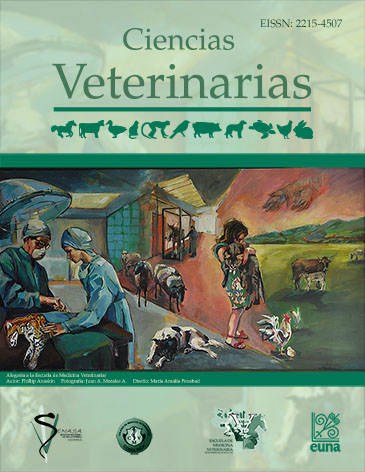Reproductive behavior of the mite Varroa destructor (Mesostigmata: Varroidae) in worker and drone brood cells of Africanized honeybees (Apis mellifera) under tropical conditions
DOI:
https://doi.org/10.15359/rcv.37-2.5Keywords:
Varroa destructor, Africanized honeybees, reproductive behavior, worker brood, drone broodAbstract
The reproductive behavior of the mite Varroa destructor in worker and drone brood cells was studied from January to August. The study was conducted using 10 colonies of Africanized honeybees (A. mellifera) from the Tropical Beekeeping Research Center (CINAT), Lagunilla of Heredia, Costa Rica. The research was divided in two phases: a) artificial mites varroa infestation of worker brood cells (n= 732) and b) artificial infestation of drone brood cells with mites taken from the worker cells (n= 362). In addition, the reproductive ability of varroa was compared between worker and drone brood cells (n= 362) and a detail analysis was conducted of the mites that did not reproduce in worker cells and were transferred into drone cells (n= 85). Each cell was examined for mite reproduction 10 days after infestation. The following parameters were measured for foundress female mites: fertility, fecundity, production of fertile females, production of immature offspring, only female or only male production and no reproduction at all. In worker brood cells, fertility rate was 76.9%; however, only 16.5% of the mites produced fertile females with an average of 1.3 ± 0.5 viable daughters. On the other hand, in drone brood cells, fertility rate was 79.3%, and 38.1% of the mites produced fertile females, with an average of 2.1 ± 0.9 viable daughters. Comparing reproductive ability of the mites showed that the fertility rate was similar in both types of brood; however, a considerable amount of the mites produced fertile offspring in the drone cells, while only 13.8% were produced in the worker cells. Furthermore, the production of immature offspring was significantly higher (over 40%) in the worker brood. One of the most relevant findings was that 74.1% of the mites that did not reproduce in worker cells were able to reproduce when transferred to drone cells, which indicates that drone brood is essential to the development and growth of varroa population in Africanized honeybees under tropical conditions.
References
Beetsma, J., Boot, W.J. & Calis, J. 1999. Invasion behaviour of Varroa jacobsoni Oud: from bees into brood cells. Apidologie 30(2-3): 125-140. Doi: 10.1051/apido:19990204
Boot, W.J., Schoenmaker, J., Calis, J. & Beetsma, J. 1995a. Invasion of Varroa jacobsoni into drone brood cells of honey bee, Apis mellifera. Apidologie 26(2): 109-118. Doi: 10.1051/apido:19950204
Boot, W.J., Van Baalen, M. & Sabelis, M.W. 1995b. Why do Varroa mites invade worker brood of the honey bee despite lower reproductive success? Behav. Ecol. Sociobiol. 36(4): 283-289. Doi: 10.1007/BF00165837
Calderón, R.A., Sommeijer, M.J., de Ruijter, A. & van Veen, J.W. 2003a. The reproductive ability of Varroa destructor in worker brood of Africanized and hybrid honey bees in Costa Rica. J. Apicult. Res. 42(4): 65-67. Doi: 10.1080/00218839.2003.11101095.
Calderón, R.A., van Veen, J., Arce, H.G. & Esquivel, M. 2003b. Presence of deformed wing and Kashmir bee virus in Africanized honey bee colonies in Costa Rica infested with Varroa destructor. Bee World 84(3): 112-116. Doi: 10.1080/0005772X.2003.11099586.
Calderone, N.W. & Kuenen, L.P.S. 2003. Differential tending of worker and drone larvae of the honey bee, Apis mellifera, during the 60 hours prior to cell capping. Apidologie 34: 543-552. Doi: 10.1051/apido:2003054.
Calis, J.N.M., Boot, W.J., Beetsma, J., van den Eijnde, J.H., de Ruijter, A. & van der Steen, J.J.M. 1999. Effective biotechnical control of varroa: applying knowledge on brood cell invasion to trap honey bee parasites in drone brood. J. Apicult. Res. 38(1-2): 49-61. Doi: 10.1080/00218839.1999.11100995.
Calis, J.N.M. 2001. Parasite-host interaction between the varroa mite and the honey bee: A contribution to sustainable varroa control. Master Thesis. Wageningen University. NL. p. 55-60.
Camazine, S. 1986. Differential reproduction of the mite, Varroa jacobsoni (Mesostigmata:Varroidae), on Africanized and European honey bees (Hymenoptera:Apidae). Ann. Entomol. Soc. Am. 79(5): 801-803. Doi: 10.1093/aesa/79.5.801.
Clarke, G.M. 1989. Statistics and experimental design. 2nd Edition. Edward Arnold, Newcastle, U.K. p. 28-30.
Contzen, C., Garedew, A., Lamprecht, I. & Schmolz, E. 2004. Calorimetrical and biochemical investigations on the influence of the parasitic mite Varroa destructor on the development of honeybee brood.
Thermochim. Acta 415(1-2): 115-121. Doi: 10.1016/j.tca.2003.06.006
Corrêa-Marques, M.H., Medina, L., Martin, S.J. & De Jong, D. 2003. Comparing data on the reproduction of Varroa destructor. Genet. Mol. Res. 2(1): 1-6.
De Guzmán, L., Rinderer, T.E., Collins, A. & Lancaster, V.A. 2001. Attractiveness of Africanized honey bee brood from Southern Texas to Varroa destructor infestation. Am. Bee J. 142(2): 130-132.
De Jong, D. 1997. Mites: Varroa and other parasites of brood. In Morse, R.A. & Flottum, K. (Eds.). Honey bee pests, predators, and diseases, 3rd Edition. A.I. Root Company, Ohio. p. 281-327.
De Ruijter, A. 1987. Reproduction of Varroa jacobsoni during successive brood cycles of the honeybee. Apidologie 18(4): 321-326. Doi: 10.1051/apido:19870403.
De Ruijter, A. & Pappas, N. 1983. Karyotype and sex determination of Varroa jacobsoni Oud. In Cavalloro, R. (Ed.). Varroa jacobsoni Oud. affecting honeybees: present status and needs. University of Wageningen, NL. p. 41-44.
Garrido, C., Rosenkranz, P., Paxton, R.J. & Gonçalves, L.S. 2003. Temporal changes in Varroa destructor fertility and haplotype in Brazil. Apidologie 34(6): 535-541. Doi: 10.1051/apido:2003041.
Al-Ghamdi, A. & Hoopingarner, R. 2003. Reproductive biology of Varroa jacobsoni Oud. in worker and drone brood of the honey bee Apis mellifera L. under Michigan conditions. Pak. J. Biol. Sci. 6(8): 756-761. Doi: 10.3923/pjbs.2003.756.761.
Hrassnigg, N. & Crailsheim, K. 2005. Differences in drone and worker physiology in honeybees (Apis mellifera). Apidologie 36: 255-277. Doi: 10.1051/apido:2005015.
Ifantidis, M.D. 1983. Ontogenesis of the mite Varroa jacobsoni in worker and drone honeybee brood cells. J. Apicult. Res. 22(3): 200-206. Doi: 10.1080/00218839.1983.11100588.
Martin, S.J. 1995a. Ontogenesis of the mite Varroa jacobsoni Oud. in worker brood of the honeybee Apis mellifera L. under natural conditions. Exp. Appl. Acarol. 19(4): 199-210. Doi: 10.1007/BF00130823
Martin, S.J. 1995b. Reproduction of Varroa jacobsoni in cells of Apis mellifera containing one or more mother mites and the distribution of these cells. J. Apicult. Res. 34(4): 187-196. Doi: 10.1080/00218839.1995.11100904.
Martin, S.J. & Kemp, D. 1997. Average number of reproductive cycles performed by Varroa jacobsoni in honey bee (Apis mellifera) colonies. J. Apicult. Res. 36(3-4): 113-123. Doi: 10.1080/00218839.1997.11100937.
Martin, S.J., Holland, K. & Murray, M. 1997. Non-reproduction in the honeybee mite Varroa jacobsoni. Exp. Appl. Acarol. 21(8): 539-549.
Martin, S.J. & Kryger, P. 2002. Reproduction of Varroa destructor in South African honey bees: does cell space influence Varroa male survivorship? Apidologie 33(1): 51-61. Doi: 10.1051/apido:2001007.
Martin, S.J. & Medina, L.M. 2004. Africanized honeybees have a unique tolerance to Varroa mites. Trends Parasitol. 20(3): 112-114. Doi: 10.1016/j.pt.2004.01.001.
Medina, L.M. & Martin, S.J. 1999. A comparative study of Varroa jacobsoni reproduction in worker cells of honey bees (Apis mellifera) in England and Africanized bees in Yucatan, Mexico. Exp. Appl. Acarol. 23(8): 659-667. Doi: 10.1023/A:1006275525463
Medina, L.M., Martin, S.J., Espinosa-Montaño, L. & Ratnieks, F.L.W. 2002. Reproduction of Varroa destructor in worker brood of Africanized honey bees (Apis mellifera). Exp. Appl. Acarol. 27(1-2): 79-88. Doi: 10.1023/A:1021579113907
Moretto, G.A., Pillati, A., De Jong, D., Gonçalves, L.S. & Cassini, F.L. 1995. Reduction of varroa infestation in the state of Santa Catarina, in Southern Brazil. Am. Bee J. 6: 498-499.
Moretto, G., Gonçalves, L. & De Jong, D. 1997. Relationship between food availability and the reproductive ability of the mite Varroa jacobsoni in Africanized bee colonies. Am. Bee J. 137(1): 67-69.
Ravazzi, G. 1995. Curso de Apicultura, 2nd Edition. De Vecchi S.A., Barcelona. p. 70-71.
Rosenkranz, P. 1999. Honey bee (Apis mellifera L.) tolerance to Varroa jacobsoni Oud. in South America. Apidologie 30(2-3): 159-172. Doi: 10.1051/apido:19990206
Schneider, S., DeGrandi-Hoffman, G. & Smith, D.R. 2004. The African honey bee: factors contributing to a successful biological invasion. Annu. Rev. Entomol. 49: 351-376. Doi: 10.1146/annurev.ento.49.061802.123359.
Vandame, R., Colin, M.E., Morand, S. & Otero-Colina, G. 2000. Levels of compatibility in a new host-parasite association: Apis mellifera/Varroa jacobsoni. Can. J. Zool. 78(11): 2037-2044. Doi: 10.1139/cjz-78-11-2037.
Wilkinson, D. & Smith, G.C. 2002. Modelling the efficiency of sampling and trapping Varroa destructor in the drone brood of honey bees (Apis mellifera). Am. Bee J. 142(3): 209-212.
Published
How to Cite
Issue
Section
License
Licensing of articles
All articles will be published under a license:

Licencia Creative Commons Atribución-NoComercial-SinDerivadas 3.0 Costa Rica.
Access to this journal is free of charge, only the article and the journal must be cited in full.
Intellectual property rights belong to the author. Once the article has been accepted for publication, the author assigns the reproduction rights to the Journal.
Ciencias Veterinarias Journal authorizes the printing of articles and photocopies for personal use. Also, the use for educational purposes is encouraged. Especially: institutions may create links to specific articles found in the journal's server in order to make up course packages, seminars or as instructional material.
The author may place a copy of the final version on his or her server, although it is recommended that a link be maintained to the journal's server where the original article is located.
Intellectual property violations are the responsibility of the author. The company or institution that provides access to the contents, either because it acts only as a transmitter of information (for example, Internet access providers) or because it offers public server services, is not responsible.







